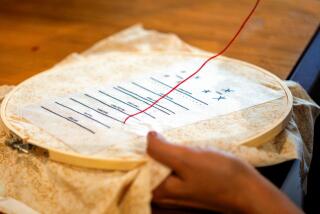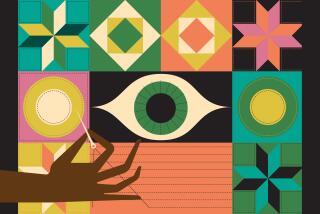Comforters : Needy: Quilting clubs donate elaborate handiwork to babies with AIDS, the homeless, and abused children. It’s time well-spent on a good cause, they say.
- Share via
Gail Thompson knows how to warm arms and legs--and hearts.
Thompson makes quilts. She’s among hundreds of sewing enthusiasts in Los Angeles who are preparing thousands of bed coverings to give away to homeless families, sick children and battered women this year before winter arrives.
Scissors and needles flash as quilters gather weekly in mall community rooms, church halls and apartment club rooms to form makeshift sewing assembly lines.
Between meetings, they work alone--their living room floors covered with brightly colored squares of cloth, hunks of fluffy lining and yards of thick backing fabric.
They are likely to spend 20 hours sewing before the last piece of thread is tied off and the quilt is lovingly folded and sent off to someone they’re unlikely to ever meet.
But that’s OK for people like Thompson, a Los Angeles bank manager who keeps cloth patches handy by filing them (by their color) in CD cabinets at her home near the Beverly Center.
“We don’t get a lot of personal feedback--we don’t always get a thank you,” she said. “But places like hospitals keep asking us for more. And that’s a compliment, as far as I’m concerned.”
Quilts were a necessity in pioneer times. Settlers often slept under corn husks or old newspapers sandwiched between stitched scraps of worn-out shirts and pieces of old blankets.
These days, quilts have evolved into an art form. And an expensive one at that.
As bedroom accessories, they can cost hundreds of dollars in stores. As wall decorations, they sometimes bring thousands in art galleries.
Quilt makers think nothing of giving theirs away, though.
“There’s a limit to how many you can put on your bed or keep as wall hangers,” said Hanna Meottel, a retired Encino office administrator whose 50-member group produced 467 quilts last year.
“The kids need them more than we do,” said Evelyn Langford, a Westminster secretarial service owner who organized a quilting group that has lasted 15 years and supplies them to babies with AIDS.
About 6,000 quilt makers are affiliated with the Southern California Council of Quilt Guilds--”our blanket organization,” as quilter Beverly Sutton, a Los Feliz school enrollment clerk, puts it.
Hobbyists belong to about 50 local guilds between Santa Barbara and San Diego and in Las Vegas. Some have as many as 400 members.
“Each guild I know of has philanthropy included as part of its charter,” said Cynthia Paul, a Woodland Hills nurse who serves as the council’s secretary when she is not sewing with three groups.
“My morning guild is Valley Quilt Makers. My evening one is called San Fernando Quilters Guild. My afternoon group is Afro-American Quilters of L.A.,” Paul said. “Quilters are not all the same. We’re very diverse.”
The 20 members of the Los Angeles Quilt Makers Guild decide each year where they want their donations to go. Meeting a few weeks ago to sew 31 baby quilts, they voted to send them to an organization called Caring for Babies With AIDS, said group President Corlis Ushijima.
Over the last 12 years, the Los Angeles guild has donated quilts to Ronald McDonald House, Los Angeles County Department of Children’s Services, Head Start, individual needy families and a YWCA shelter for battered women, according to Ushijima--a secretary who lives in the Wilshire district.
Last week, homeless shelters received the first of 200 handmade quilts from 30 members of Trinity Lutheran Church in Hawthorne. The group, working in conjunction with the Ortho Mattress Co., calls itself the Comforters.
Victims of the Northridge earthquake received quilts from the Valley-based Quilters for Others in January. That 50-member club has also donated quilts to a shelter for battered women, an Alcoholics Anonymous recovery home and to an organization for retarded people.
The Simi Valley Quilt Guild has given small quilts to local police for use in comforting children who have been abused or have become separated from their parents. Simi quilters have also auctioned quilts and donated the proceeds to a local free clinic.
Selling handmade quilts as charity fund-raisers is also popular with some Los Angeles-area hobbyists.
The South Bay Quilters Guild has held shows and raffles to raise cash for a family center and for a shelter for homeless pregnant women.
Members of a Van Nuys Jewish group called Hamish Amish Quilters auctioned one of their bed covers at a Fourth of July party for $1,700 and contributed the money to an anti-nuclear weapons organization.
The Diabetes Quilt Guild of Los Angeles sold its members’ handiwork, along with donated quilts from across the country, to raise about $20,000 a year or so ago for diabetes research.
But most quilters prefer to donate quilts directly to organizations that need them.
Quilter Linda Graham of West Los Angeles said the 13 members of her group learned “we weren’t that good at raising money” when they began holding auctions in 1980.
So for the last decade they have donated 100 quilts a year to such places as hospitals, a Skid Row children’s project, church-based assistance groups, an AIDS hospice and a shelter for babies born with AIDS, she said. This year’s output is headed to a child care facility for babies born addicted to drugs or alcohol.
Infants and toddlers at the Bienvenidos Children’s Center in West Covina will be able to keep their quilts forever, said Lorraine Castro, the facility’s executive director. Many of them arrive with only the clothes on their back.
“It’s an incredible gift. Quilts remind you of mommy and home. The children sleep with them, they take them with them when they leave,” Castro said. “A quilt is comforting. It’s something to hold on to that’s really yours.”
Although quilting conjures up images of grandmothers in rocking chairs, local hobbyists include a smattering of men and numerous young women. And interest continues to grow--something that is a far cry from the 1950s and ‘60s, according to quilting council President Patty McCormick of Corona del Mar.
“It almost died out because blankets back then were so cheap,” said McCormick--who has been selected to serve as a consultant on an upcoming movie from Steven Spielberg’s Amblin Entertainment. The film is about seven woman in a quilting group that has lasted 35 years.
If quilting is a traditional craft for some, it’s an up-to-date one for many.
Quilters gather for “meetings,” not “bees,” said Lillian Grodsky, who is in her 80s and lives in Park La Brea. “The word bee is kind of old-fashioned. We’re modern.”
Joanne Bloomfield agrees with that. She’s a college textiles professor from Northridge who stitches “while I’m watching the O.J. (Simpson) case on TV.” She watches her computer screen for quilting inspiration.
“There’s a quilting forum on CompuServe at 7 o’clock every Tuesday. It’s an extension of conversations we have at quilting meetings,” she said.
Enthusiasts can design quilt patterns by computer if they want to, she said. And some new sewing machines can even be hooked up to be run by computer.
But Bloomfield isn’t worried that automation will replace the sewing circle.
“Quilts are personal things,” she said.
More to Read
Sign up for Essential California
The most important California stories and recommendations in your inbox every morning.
You may occasionally receive promotional content from the Los Angeles Times.







